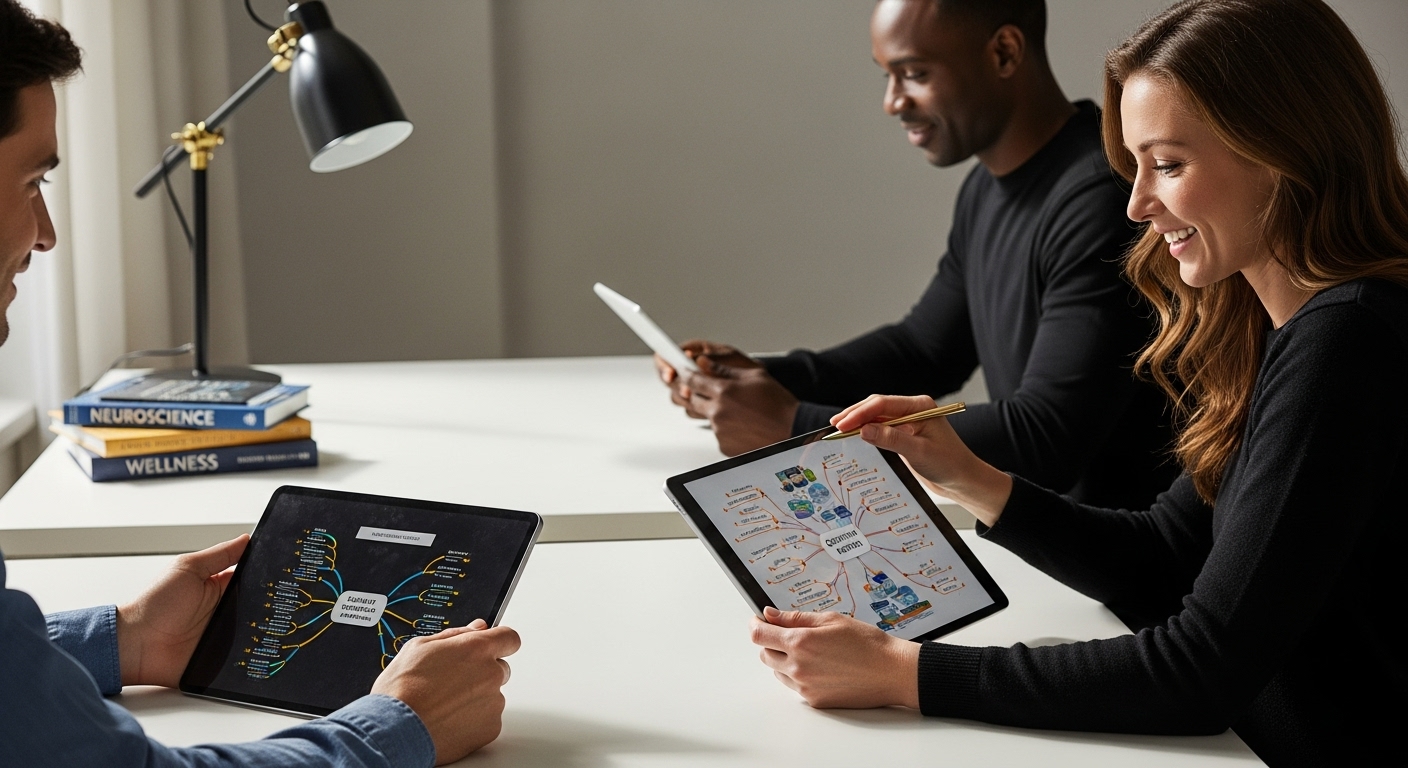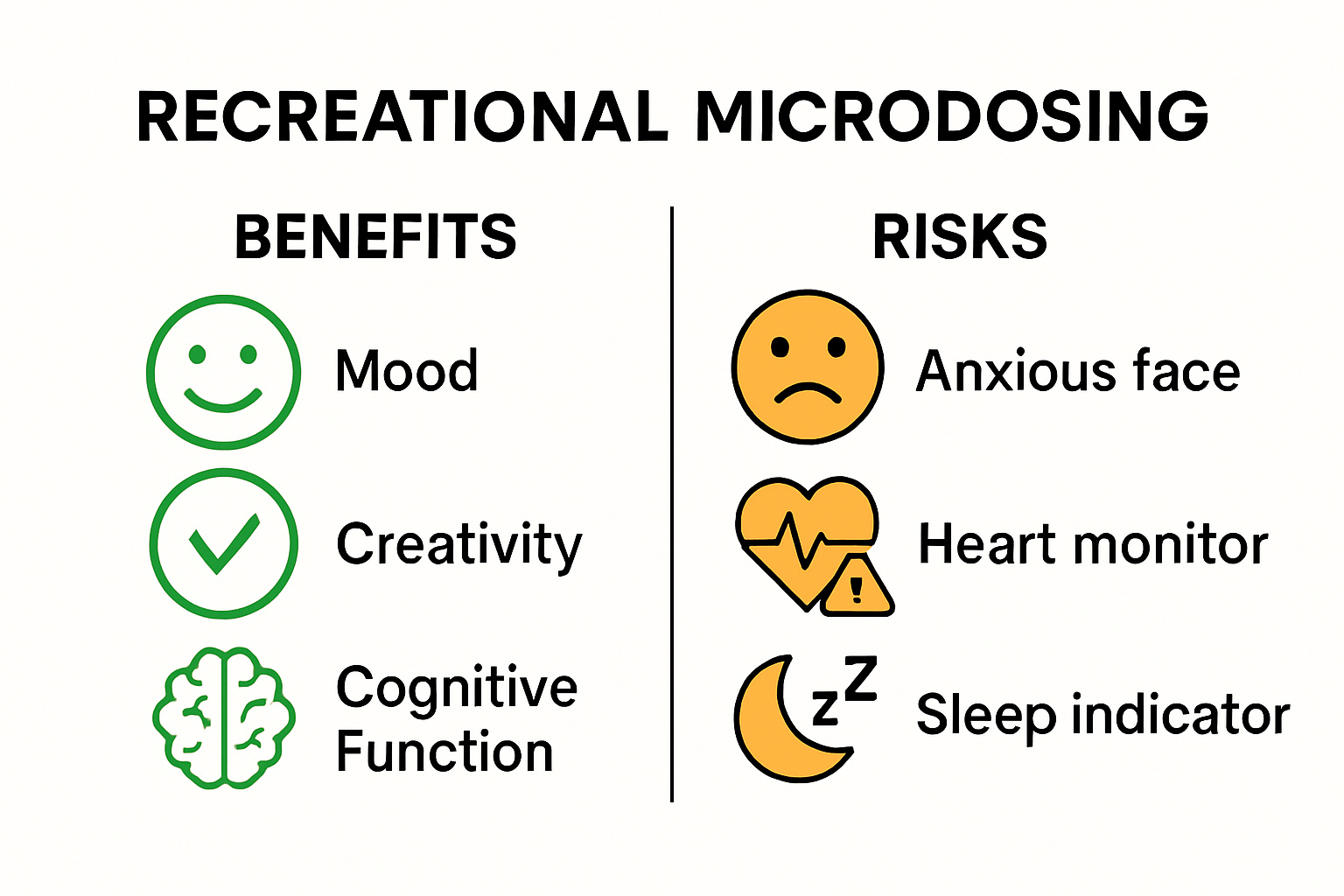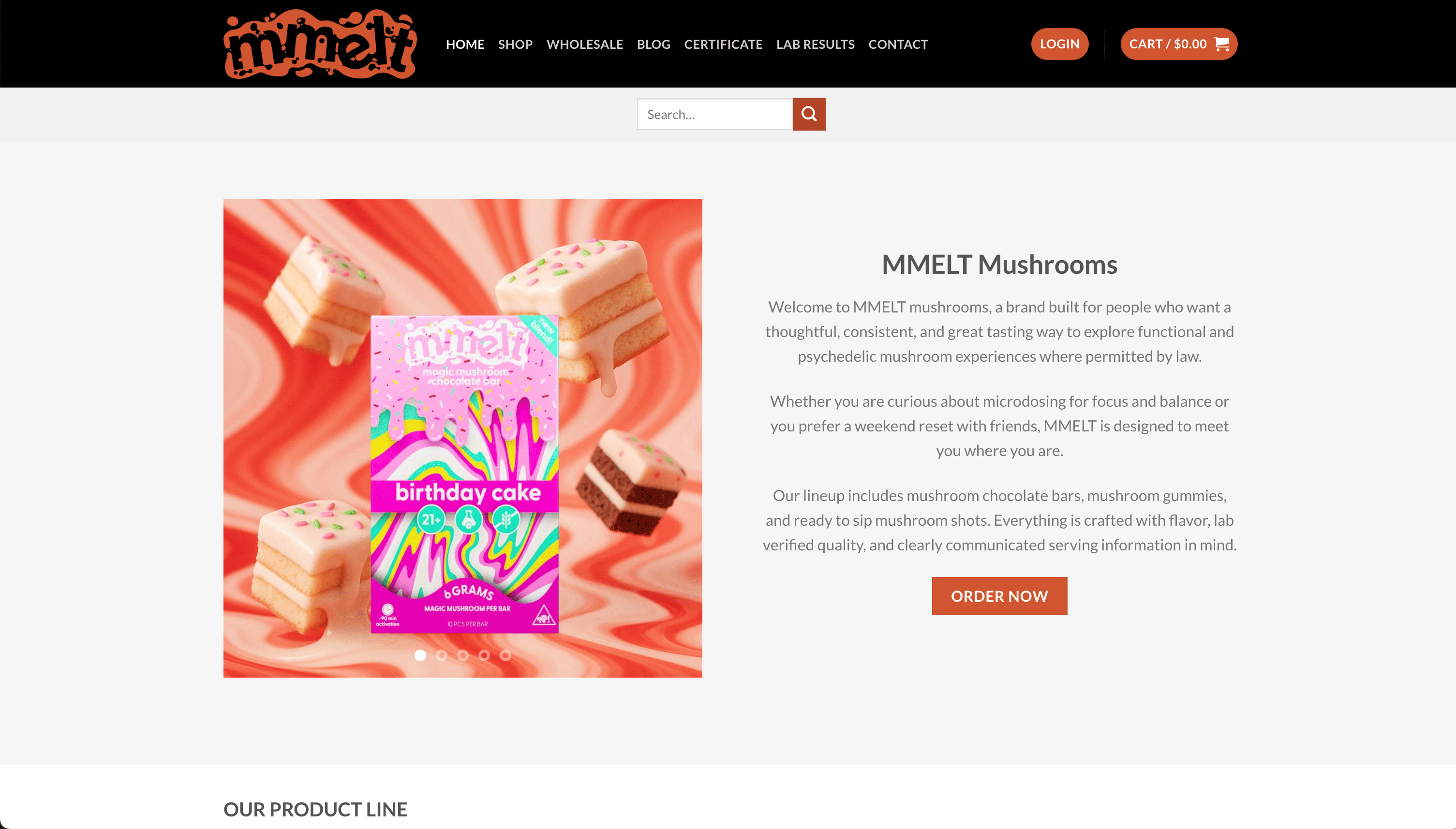Blog
What is Recreational Microdosing? Understanding Its Impact
Recreational microdosing has sparked global debate as more people experiment with mind-altering substances in ultra-low doses. Some estimate over 20% of young adults in tech hubs like Silicon Valley have tried microdosing for cognitive benefits. Most think psychedelics are about wild trips and vivid hallucinations, right? Actually, microdosing is all about subtle changes that most users do not even notice and it is shaking up ideas about wellness and mental performance in surprising ways.
Table of Contents
- Defining Recreational Microdosing: Key Concepts Explained
- The Science Behind Microdosing: How It Affects The Brain
- Benefits and Risks of Recreational Microdosing
- Cultural Context: Recreational Microdosing in Society
- Navigating the Future of Recreational Microdosing
Quick Summary
| Takeaway | Explanation |
|---|---|
| Recreational microdosing uses sub-perceptual doses | This practice involves consuming 5-10% of typical psychedelic doses for subtle enhancements without hallucinogenic effects. |
| Microdosing can enhance cognitive flexibility and mood | Participants report improved emotional regulation, creativity, and overall mental well-being through these minor neurological changes. |
| Risks include anxiety and sleep disruptions | Users should be aware of potential health impacts, necessitating careful consideration of personal health history before microdosing. |
| Cultural shifts are driving microdosing popularity | The practice reflects increasing interest in personal wellness and alternative mental health approaches among various demographic groups. |
| Robust research is needed to validate microdosing effects | The scientific community calls for more controlled studies to explore long-term impacts and safety profiles of recreational microdosing. |
Defining Recreational Microdosing: Key Concepts Explained
Recreational microdosing represents an emerging practice where individuals consume small, sub-perceptual quantities of psychoactive substances to achieve specific psychological or functional enhancements. Unlike traditional recreational drug use, microdosing aims to produce subtle neurological changes without inducing full psychedelic experiences or significant alterations in perception.
To clarify the main characteristics and distinctions of recreational microdosing, the following table outlines key features that differentiate it from conventional psychedelic use and highlights its unique aspects for readers.
| Feature | Recreational Microdosing | Conventional Psychedelic Use |
|---|---|---|
| Dose Size | 5-10% of a standard dose | Full/standard dose |
| Primary Goal | Subtle cognitive/emotional enhancement | Hallucinogenic or intense experience |
| Perceptual Changes | Minimal to none | Pronounced, vivid hallucinations |
| Frequency | Periodic and structured | Occasional or event-driven |
| Focus | Function, wellness, performance | Recreation, spirituality, therapy |
| Awareness Level | Sub-perceptual (often unnoticed effects) | Noticeable, often profound effects |
| Community Influence | Growing, wellness-driven | Established, countercultural roots |
The Fundamental Definition
At its core, recreational microdosing involves consuming approximately 5-10% of a standard psychedelic dose. These minuscule quantities are designed to create mild neurological shifts without triggering intense hallucinogenic effects. According to research from Johns Hopkins University, participants report experiencing nuanced improvements in mood, cognitive function, and overall mental well-being.
Key characteristics of recreational microdosing include:
- Intentional and controlled substance consumption
- Sub-perceptual dosage levels
- Focus on functional enhancement rather than recreational intoxication
- Periodic and structured consumption patterns
Psychological and Neurological Mechanisms
The neurological foundation of recreational microdosing centers on how trace amounts of psychoactive compounds interact with brain receptors. These interactions potentially modulate neural connectivity, neurotransmitter release, and cognitive processing. Scientific investigations suggest that microdosing may influence serotonin receptors, potentially explaining reported improvements in mood regulation and cognitive flexibility.
While the practice remains controversial, growing interest has prompted researchers to explore its potential therapeutic and personal development applications. For those curious about understanding this emerging trend, our guide on legal microdosing offers comprehensive insights into the evolving landscape of controlled psychedelic consumption.
The Science Behind Microdosing: How It Affects the Brain
The neurological mechanisms of microdosing represent a complex interplay between psychoactive substances and brain chemistry, offering intriguing insights into cognitive enhancement and neuroplasticity. Unlike traditional pharmaceutical interventions, microdosing explores subtle neurochemical modulations that potentially reshape brain function without inducing dramatic perceptual changes.
Neurochemical Interactions and Receptor Dynamics
At the molecular level, microdosing primarily influences serotonin receptors, particularly the 5-HT2A receptor sites. Research from the National Institutes of Health demonstrates that these interactions can fundamentally disrupt the brain’s default mode network, a neural system responsible for self-referential thinking and habitual cognitive patterns.
Key neurological processes triggered by microdosing include:
- Enhanced neural connectivity
- Increased neuroplasticity
- Modulation of neurotransmitter release
- Potential reduction of inflammatory neural responses
Cognitive and Emotional Regulation Mechanisms
Microdosing appears to work by creating subtle shifts in brain connectivity and neurotransmitter dynamics. The trace amounts of psychoactive compounds interact with neural receptors, potentially promoting neurogenesis and synaptic flexibility. This suggests that microdosing might help individuals break entrenched cognitive patterns, offering potential therapeutic applications for mood disorders and cognitive rigidity.

For enthusiasts interested in understanding the deeper scientific landscape of psychedelic compounds, our comprehensive guide on psychedelic mushrooms provides additional context about these fascinating neurological interactions.
Benefits and Risks of Recreational Microdosing
Recreational microdosing occupies a complex landscape of potential psychological enhancements and potential health considerations. Understanding the nuanced spectrum of outcomes requires a balanced examination of both positive potential and possible adverse effects associated with this emerging practice.
Potential Psychological and Cognitive Benefits
Microdosing presents several intriguing potential benefits for mental performance and emotional regulation. Research from comprehensive scientific reviews suggests individuals may experience significant psychological improvements, including:
- Enhanced mood regulation
- Increased cognitive flexibility
- Reduced symptoms of anxiety and depression
- Improved creative problem solving
- Greater emotional resilience
These potential benefits stem from subtle neurochemical interactions that can modulate brain connectivity and neurotransmitter functionality without producing intense perceptual alterations.

Potential Health Risks and Considerations
While promising, recreational microdosing is not without potential risks. Systematic scientific investigations highlight several important health considerations that individuals must carefully evaluate. Possible adverse effects can include:
This table summarizes the potential psychological benefits and health risks of recreational microdosing as discussed in current research and throughout the article, giving readers a clear overview of possible outcomes.
| Aspect | Potential Benefits | Potential Risks |
|---|---|---|
| Mood Regulation | Enhanced mood stability, emotional resilience | Increased anxiety (in some individuals) |
| Cognitive Flexibility | Improved creativity, greater problem-solving ability | Cognitive disruptions (rare, individual)-based |
| Anxiety/Depression | Reduced symptoms for some users | Minor cardiovascular changes |
| Creativity | More original thinking, solutions to challenges | Sleep disturbances |
| Emotional Wellness | Heightened self-awareness, better regulation of emotions | Individual variability in neurological effects |
| Social/Professional Life | Improved productivity, alternative mental health management strategies | Not suitable for all health profiles |
- Temporary increases in physiological anxiety
- Minor cardiovascular changes
- Potential disruptions in sleep patterns
- Individual variability in neurological responses
Important safety considerations emphasize the necessity of understanding personal health history, potential pre-existing conditions, and individual neurochemical sensitivities before engaging in microdosing practices.
For individuals interested in exploring the nuanced differences between various psychedelic compounds, our comprehensive guide on mushrooms versus synthetic psychedelics offers deeper insights into the complex world of psychoactive substances.
Cultural Context: Recreational Microdosing in Society
Recreational microdosing has emerged as a complex social phenomenon, reflecting broader cultural shifts in approaches to personal wellness, cognitive enhancement, and alternative therapeutic practices. This practice represents more than a trend it signifies a profound reimagining of how individuals perceive mental performance and emotional regulation.
Social Dynamics and Motivational Landscape
Research from Frontiers in Psychiatry reveals that microdosing has gained significant traction among specific demographic groups seeking innovative approaches to personal development. The motivational spectrum for recreational microdosing encompasses diverse objectives:
- Enhanced professional productivity
- Alternative approach to mental health management
- Exploration of cognitive potential
- Spiritual and personal growth
- Creative problem solving
These motivations reflect a broader societal movement toward personalized, proactive approaches to mental wellness that challenge traditional pharmaceutical and therapeutic paradigms.
Community and Identity Formation
Recreational microdosing has cultivated unique subcultures characterized by shared experiences, knowledge exchange, and collective exploration of consciousness. Practitioners often form tight knit communities through online forums, social media groups, and grassroots networks that facilitate information sharing and normalize these emerging practices.
Emerging social dynamics suggest that microdosing represents more than a pharmacological experiment it is a cultural statement about individual agency, cognitive optimization, and alternative approaches to mental health. For enthusiasts seeking deeper understanding of psychedelic compounds, our comprehensive guide on psychedelic mushrooms provides additional context about these fascinating cultural interactions.
Navigating the Future of Recreational Microdosing
The landscape of recreational microdosing stands at a critical intersection of scientific research, cultural evolution, and emerging regulatory frameworks. As interest continues to grow, the future of this practice hinges on comprehensive scientific understanding, ethical considerations, and responsible community engagement.
Research and Scientific Validation
A comprehensive systematic review underscores the urgent need for rigorous scientific investigation into microdosing. The current research environment demands more robust methodological approaches to understand the long term implications and potential benefits of this practice.
Key areas requiring further scientific exploration include:
- Standardized research protocols
- Long term neurological impact studies
- Comprehensive safety profile assessments
- Controlled clinical trials
- Neurochemical interaction mappings
The scientific community recognizes that anecdotal evidence cannot replace empirical research, making systematic investigation crucial for understanding microdosing’s true potential and limitations.
Regulatory and Ethical Considerations
The future of recreational microdosing will be significantly shaped by evolving legal and ethical frameworks. Emerging discussions center on creating responsible guidelines that balance individual autonomy with public health considerations. This involves developing nuanced approaches that acknowledge the potential therapeutic benefits while mitigating potential risks.
For enthusiasts seeking deeper insights into the complex world of psychedelic compounds, our comprehensive guide on psychedelic mushrooms offers an in depth exploration of these fascinating substances and their potential implications.
Discover Microdosing with Confidence and Clarity
If you are intrigued by the science and personal benefits of recreational microdosing discussed in our article, you might be facing questions about where to find products you truly trust. Maybe you are searching for high-quality, lab-verified mushroom edibles that help you achieve subtle cognitive enhancement without uncertainty or confusion. At MMELT Mushrooms, we understand the desire for transparency, safety, and consistency in your microdosing experience.

Take the next step toward mindful and responsible microdosing. Explore our mushroom-infused edibles for clear labeling, third-party testing, and detailed product descriptions. Start your journey with reliable information and outstanding flavor, or learn more by reading our educational blog. Discover why so many adults trust MMELT Mushrooms as their source for mushroom products designed to fit personal goals and responsible lifestyles. Visit MMELT Mushrooms today for quality and peace of mind.
Frequently Asked Questions
What is recreational microdosing?
Recreational microdosing involves consuming small, sub-perceptual amounts of psychoactive substances to enhance cognitive or emotional functions. The doses are typically around 5-10% of a standard psychedelic dose, aimed at improving mental well-being without eliciting full psychedelic effects.
How does microdosing affect brain function?
Microdosing affects brain function by influencing serotonin receptors, particularly the 5-HT2A receptors, leading to improved neural connectivity and neuroplasticity. This can enhance cognitive flexibility, mood regulation, and emotional resilience without the intense perceptual changes associated with higher doses.
What are the potential benefits of recreational microdosing?
Potential benefits of microdosing include enhanced mood regulation, increased cognitive flexibility, reduced anxiety and depression symptoms, improved creativity, and greater emotional resilience. These effects arise from subtle neurochemical interactions rather than dramatic alterations in perception.
Are there risks associated with recreational microdosing?
Yes, there are potential risks, including increased anxiety, minor cardiovascular changes, sleep disturbances, and varying neurological responses among individuals. It’s essential to consider personal health history and pre-existing conditions before engaging in microdosing practices.
Recommended
- Understanding What is Legal Microdosing
- 7 Key Insights
- Mushrooms vs Synthetic Psychedelics
- Understanding Mushroom Edibles vs Dry Mushrooms

